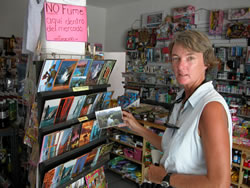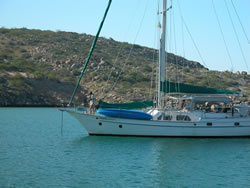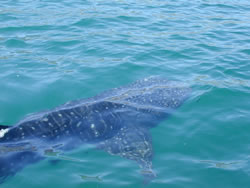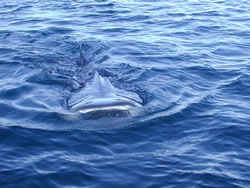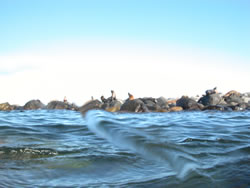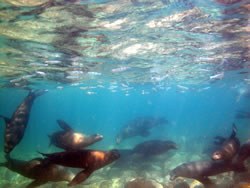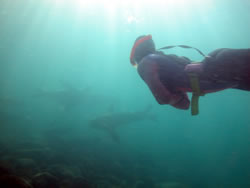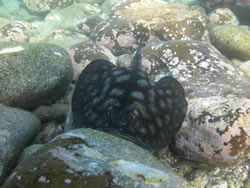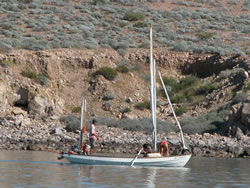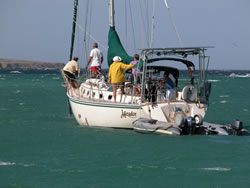|
HOME |
LOGBOOK |
| Volume
102 Change of Plans Weighing the columns of plusses and minuses, the most sensible alternative was to split up: one of us to go north to help out in Indiana while the other stayed to take care of the boat through the rest of hurricane season. Which is how it happened that Don climbed into the van driven by another cruiser and filled with all the items salvaged from Spirit Healer (see last Log entry) and drove away from Bahia Los Angeles, leaving me, the distaff captain behind. Single-handing spouses are not an uncommon sight in the Sea, but it is usually the wife who goes “home” for shopping trips, grandparent time, or, sometimes, just get-off-the-damn-boat time! The fleet is not accustomed to seeing the woman left to do the single-handing bit. When I pulled back in to Puerto Don Juan to reclaim my spot as Hurricanes Nora and Olaf played tag to the south, a flurry of dinghies rushed out to “help me get the anchor down.” I thanked them all and did it myself. All in all, it has been a very good month for me. Obviously, Don would never have left me if he didn't believe me capable of coping with the boat on my own, but I can't deny that there were a lot of chores at which I'd gotten a bit rusty after seven years of depending on el macho capitán. After thirty-two days, eleven moves, a couple of hundred miles, and one “norther”, I have to say I feel pretty much back up to speed. I will also be real glad to have Don back. What a lot of work it is to do ALL the chores! Take hunting, for example. Before Don left I had a couple of lessons in using the speargun. My aim is okay, and my ability to dive deep and stay there an asset, but pulling back the rubber bands that cock the gun was almost impossible! What a weenie! I could get one of the three bands back, but not the others, and that first one only once or twice an outing. So, at the outset, I pretty well had to stick close to one of the guys – Dennis, Paul or Mike – to get rearmed if I didn't get my fish on the first shot. By the end of the month, however, I could rearm two bands indefinitely, which was enough to get a fish for dinner. But getting the fish is just one part of the whole operation. You've got to load the gear, get to the site, find the fish, arm the gun, shoot the fish (x however many shots it takes), go home, clean the gear, stow the gear, FILLET the fish, cook the fish, eat the fish, and DO THE DISHES. Yikes, that's a lot of work for a fish taco! Of course, I may have been single-handing but I was never alone. Wherever I went there have been other cruisers, most importantly the Tres Amigos…actually now the Cuatro Amigos with the addition of Jerry on Mirador . Although I did 99% of the boat stuff on my own (it took two to get the dinghy and dinghy engine up and down as well as to get the headsail back up after the hurricane threats finally passed), my friends were always at hand to keep me distracted. There were potlucks and cribbage matches and snorkeling trips and beach walks, dinners out and provisioning runs, and, of course, hunting forays. I'd had this foolish idea I'd have time on my hands for writing projects and intensive reading, but between all of the activities and the twice-daily emails to Captain Indiana , I found myself with virtually NO spare time! Early on in the month, we didn't travel far. The threat of developing hurricanes aiming for Baja seemed never to die down, so no one wanted to venture far from the proven safety of the Puerto Don Juan hurricane hole. (Although we had threats – Nora, Olaf, Patricia, we never had another storm come into the Sea!) To entertain ourselves in the BLA area, the Amigos made a real effort to see some of the other sights of the area. Beyond the museum (see Update #100 – Bahia Los Angeles) which revisited, BLA is known for its turtle farm, some modest cave paintings and an annual visit by whale sharks. The Turtle Farm The most interesting thing we learned is that the loggerhead turtle, although often seen and caught in these waters, nest nowhere in the Eastern Pacific. Studies made by the station by tagging turtles caught and released in Baja show that these individuals cross the Pacific to return to their nesting grounds in Japan! That 6000-some miles one way! On third of the planet! One helluva puddlejump! Plus, it is believed they make the round trip at least twice in their lives, drawn by the rich waters off Baja! What is sad is the fact that the two most famous of the station's turtles—Rosita and Adelita – both made their contribution to science after their bodies were recovered from Japanese fishing nets. Cave Paintings However, the scenery on the drive to the canyon was glorious and well worth the trip. Thanks to Marty's rain, the desert was lush and green. Flowers like morning glories framed the highway, with forests of cardón,, datillo, pitthaya as well as of the very odd-looking Cirio. Also known as “the Boojum tree”, the Cirio looks like something from the pen of Dr. Seuss. For the last part of the trip on a sand track the “forest” was so dense there was actual shade. Our driver, Martin, stopped several times to cut for us the fruits of the pitthaya cactus. Kind of like a cross between a strawberry and a kiwi and about the size of an apple, the pitthaya is refreshingly juicy…once you get past the spines! Whale Sharks, Ho! Don and I had made a feeble attempt to find the whale sharks in Bay of LA last year, but not really knowing what to look for (being sharks and not whales, they don't spout!) or precisely where, we struck out. This year, when we arrived in BLA, we learned the whale sharks hadn't made their usual annual appearance. Dozens of marine biology students expecting to catch them here last month also struck out. So, having heard a rumor that some had finally been seen, I urged our little armada to change plans in order to cruise slowly down the length of the bay here. I still didn't know what I was looking for, and it still is a very big bay. We spread out three abreast. I rigged our remote control to the autopilot (rarely used) and stood up on the deck box with the binoculars. Almost no sooner than I got all set up than I saw a funny fin in towards shore. The bay is full of dolphin and sea lions, so a fin isn't an unusual sight, but this one was rounded, and was followed by a second floppy fin. Then there was a second pair. I steered Tackless closer and suddenly I was sure. I cut the engine to let the boat drift (proper ecological maneuver--you are supposed to let them come to you) and hailed the other three boats, now way ahead of me.) While I was on the radio, the huge creature did indeed start swimming towards me, just under the surface. I scurried to the back deck, and the whale shark swam right up to the stern. It looked for all the world like he was eyeing me...or about to kiss Tackless on the transom! It was no more than two feet off! Then it ducked under the boat! We're talking a fish nearly half the length of the boat!! (Our camera, of course, failed.) Lady Galadriel was next on the scene; they had one whale shark on each side of their boat, albeit not quite as close. Ryokosha caught up to us just as three pangas loaded with tourists roared up practically on top of the creatures and all their passengers piled in the water shrieking. ( This is NOT the proper ecological approach!) I was itching to get in the water, but obviously I could leave T2 adrift, so I fired the engine back up and scoped out the anchoring along the beach. All the others followed suit and, once the pangas had left, we piled into our dinghies to get closer. I brought my mask and fins, and when we found another whale shark, I got in the water. Now I know they aren't supposed to be harmful to humans, but, man, they are big. It's a little unsettling. The water was a bit green, and they move right along, so they would materialize and dematerialize somewhat abruptly!. Paul of Ryokosha also got in the water, and he did grab the passing fin for a short ride. Also an ecological no-no, but definitely a memorable thrill for him and evidently little bother to his ride. Divided among about four dinghies, we drifted and paddled for a couple of hours watching the huge creatures feed. Every time a dinghy would move into its area and shut down, the whale shark almost invariably would come make a close pass to check it out. In a dinghy, a close pass is within arm's reach! They swim with their huge mouths agape filter feeding plankton, apparently swimming a pattern, swish-swish-swish-turn, 180 degrees and back. Our “guys” were all swimming right at the surface so we could often get a good look right into their gullets. Look out, Jonah! As the afternoon waned, the sightings ran out, but the next morning Lisa and I saw four more on a dinghy run to town, and a week later they came right into the town anchorage! The whale shark is the world's largest fish. It has a wide flat head with a wide mouth and a wider-still body. It's color can vary from blue to brown (ours were all brown), but they have very characteristic markings of vertical and horizontal lines with white dots, giving them a checkerboard pattern. They can reach lengths up to forty feet, but normal adult size is 26-29 feet. The ones we saw ranged in length from 8-16 feet, so we assume they are immature. A little research reveals that whale sharks are oviviparous, that is they bear live young, producing huge litters of up to 300 babies about 18 inches in length! So ours, at the very least, were teenagers! The Migration South
This trip was a great day. The seas were flat and the current with us, so we made great way. For some reason I never got bored. I had a good book, and in the afternoon we ran into a long parade of huge whales – fin whales, we guess – chugging northward on the surface like bluff-bowed submarines! They were everywhere and close at hand, spouting away merrily and easily seen in the glassy seas. Way off to the west I noted one group of six spouts packed so tightly together and spouting so steadily it looked like a fountain. We even had a few tail flips! Unfortunately, our late departure put our arrival at Isla San Marcos close to midnight . I wasn't much worried as the anchorage there is wide open, familiar and marked by a lighthouse. What I hadn't counted on were the squid fishermen. For some reason, none of us realized that squid fishing was still going on! As we approached we encountered several clusters of the white lights that these pangas use to mark themselves. After a long tiring day, it was an uncomfortable exercise to thread ones way through them, even with radar. On Tackless , our radar set-up presumes two people: one to drive and one to look at the radar, which is mounted at the front of the cockpit. Even on its dimmest setting, when not covered it casts a distracting glow on the underside of the hardtop. It is very hard to see! Compared to BLA, the nearby town of Sta Rosalia is a metropolis with its own Pemex fuel station, a half dozen markets, a bakery, a nice fruiteria , despositos (beer vendors), Internet cafes and banks. St. Rosalia (you may remember from last year) even has its own little marina, which would have been a very logical place for me to collect Don. It was, however, full, with several boats waiting at anchor. It also has a port captain, which means that even a short visit for fuel requires the complete entry procedure complete with fees. There were lots of rumors flying that you could come in for fuel without entering, but a call to the Capitania nixed that idea. Instead, we left Tackless II and Lady Galadriel at anchor and piled on one boat – Mirador – with all our fuel jugs and made the trip in that way. Not only did we not get away with not clearing in, but poor Jerry was beseiged by a truckload of Navy guys with a drug sniffing dog! It made the whole day a real pain, especially for Jerry, and we weren't able to get away until just about sunset. Yup, you guessed it. More squid fishermen. In fact, right after dark there must have been hundreds all strung out between Baja and Isla San Marcos so that it looked like we were driving into a good-sized city. Captain Gwen's Fish Story Holy sh-t, Batman, I'd got a marlin! T2 was still barreling along at 6 knots (make a note, always throttle back when single-handing.) So there I was...stuck on the back deck, holding the rod with all my strength. I didn't want this fish, but I wanted the rod, and I'd like the lure. I was sure he would shake it when I set the brake, but he didn't. Perhaps the 6 knots had something to do with that. I managed to get a few wraps cranked on the reel. The fighting belt was still stowed below, so I wedged the rod between my body and the arch and the bucket. Essentially, I was stuck there. I could imagine being stuck there for hours until the boat ran aground at Punta Chivato! (Make a note, always course to open sea when single-handing.) Dennis and Lisa kept talking on the radio. Like I could get to the radio! Finally, I managed to get the rod back into the rod holder. I dashed to cockpit and we all consulted on how to get this thing OFF. I was not pleased: the order on the hook said "SIERRA". What is a marlin doing going after that little teeny weenie lure! Jerry suggested coming to a stop and letting the fish use the slack to shake it off. So I put T2 in neutral, dashed back to the rod just as it was nearly yanked out of the holder and the holder nearly swiveled around the bar it's clamped to. This went on long enough for Lady Galadriel and Mirador to turn around and motor back. Finally the line went slack and I started to reel it in, but no, he was still there. He was flopping out front in front of Mirador . At last, he swam the line around in front of the boat and snapped the line. Bye bye, lure. Isn't it always the one that works! When I emailed Captain Indy that night, I told him I wasn't sure which he preferred, that I should have nice boring days that don't make him either worry about me or wish he were here, or that I should have days full of excitement for great story telling. Well, now I have the hook down in Playa Burro, this year's “in” anchorage in Bahia Concepcion, and I am back in the middle of mostly the same boats Don left me with in Puerto Don Juan a month ago. There is cheap food at Bertha's, and it's a hot bed of cribbage. Don is due back by bus in the next day or so. He will slip the driver a few pesos to pull over and drop him off by the roadside where it passes right by the anchorage (a wonderful convenience of the Mexican bus system.) I have been a whirling dervish of scrubbing, cleaning and fueling so that his ladies will be in their best form for his return. We both can't wait to have him back aboard. T2 just isn't the same without her TWO captains. |
|
home
| waypoints | logbook | reference shelf
|

